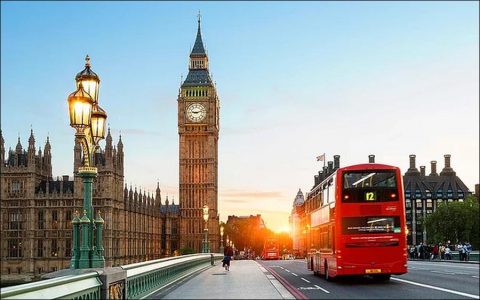The city being taken as the heart of London, there are two main arteries by which its blood is put in circulation. One is Holborn, prolonged by Oxford Street and the Uxbridge Road, so as to make almost a straight line through the metropolis, continued eastward from Aldgate along the great Whitechapel highway, in all a distance of some ten miles for a bee that had spare time to measure it from Bow Bridge to Hammersmith.
The other, beside the curving bank of the river, has a shorter stretch of a mile or so to the central ganglion where it branches into several veins; yet its former course may be roughly followed by Pall Mall and Piccadilly, along the Parks and through Kensington High Street on to Kew Bridge. If any thoroughfare is to rank as chief street of all London, it is the Strand, till the other day choked by double tides of business and pleasure, but now opened out more roomily, and its channel seconded by the broad Thames Embankment, on to which a fleet of tramcars has at last broken way.
The still raw cut of Kingsway is also drawing traffic into a new current But, as we saunter towards Charing Cross together, we shall follow the Strand as our main line, with peeps of exploration on either side. Its name may at least serve us as a text for considering certain aspects of London life, old and new. If a more fanciful title were wanted for this chapter, one might call it “All the World’s London.”
Beyond Temple Bar, the offices of business merge into a quarter chiefly noted for houses of entertainment. One must not count the Courts of Justice under a head that would seem a mockery to anxious suitors, not to speak of nervous witnesses and impatient jurymen. Yet here are often enacted thrilling spectacles to draw as eager crowds for admission as do any of the Thespian temples neighbouring this modern shrine of Thames, which some aver to be dedicated rather to Æolus, though all its draughts do not clear it of what has been described as “an amalgamated effluvium, a reek of stuff gowns, dog’s-eared papers, mouldy parchment, horsehair wigs, imperfectly washed spectators, police constables and witnesses, with a bracing whiff of ammonia from the wood pavement in the Strand outside.
What one can say without fear of contempt of court, is that the Strand and its side streets are much given up to theatres, music-halls, restaurants, and hostelries of all kinds, making this the part of London most familiar to strangers, and perhaps to some Londoners. In the depths of Transatlantic backwoods, I once foregathered with a countryman holding a commission in the “Lost Legion”; and his first question of home was, how fared the Alhambra or some such rendezvous of pleasure-seekers. Had St. Paul’s or Exeter Hall been his focus of regard, he might not have come to play the “remittance man” so far away.
In the Strand itself it was my chance to meet a young American seeking direction to Furnival’s Inn, where he desired to lodge because Dickens lived in that “hotel.” Again, I have known another New Englander ready to quarter himself upon the “House” of a celebrated Briton, because he took this title to imply an hotel, as it did in Boston. The Dickens enthusiast was not so far out, since at that time a lodging for strangers was contained within Furnival’s Inn, now rebuilt as an Insurance Office by a Company so prudential in its dealings as to have become one of the great landlords of London.
Inns, in our fathers’ sense, seem to be shrinking out of existence or swelling themselves as “hotels”; but in this part of London there are still “Inns” of much dignity that do not offer accommodation to “transient” guests. The name that began as meaning a large house, is still borne in honour by the Inns of Court, where successful lawyers now have their chambers rather than their homes; and would-be successful ones have at least their names on a door to which clients may or may not come.
The unsuccessful are not now so “contented to sleep in dingy closets, and to pay for the sitting-room and cupboard which is their dormitory, the price of a good villa and garden in the suburbs”; but some Spartan Templars still spend dusty years in a cramped, rat-riddled garret, perhaps on no sweeter fare than eating their hearts out for disappointment and envy of more fortunate brethren.
Looking back to the companions of my own youth, I see how those harnessed to the law have for good or ill not always sped according to promise or expectation. In this career, especially, it seems as if a certain baser alloy were useful in tempering intellectual gold. The Inns of Court, as we all know, are time-honoured and dignified institutions, each with its Chapel, its Library, and its Hall, through which latter aspirants eat their way to the Bar, now fenced, indeed, by more intellectual ordeals; but the final stage is marked by the ceremony of a call supper, when libation seems the chief rite.
The most illustrious of these Inns is the Temple, in which arms may be said to have ceded to the gown. It was the home of that proud, rich, and envied order of Knights Templar, who at the end of the twelfth century moved here from Holborn, like a prosperous barrister rising from Bloomsbury to Belgravia. Here, in imitation of that of the Holy Sepulchre they were vowed to defend, they built one of their round churches, now owned by a fraternity more devoted to law than to Gospel.
Hits: 797
